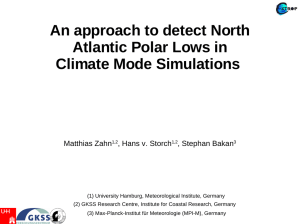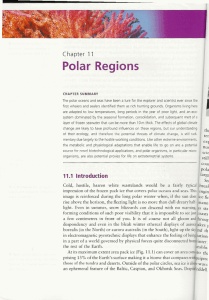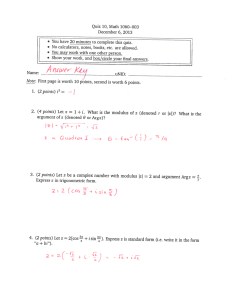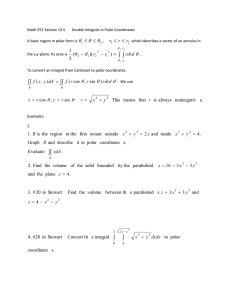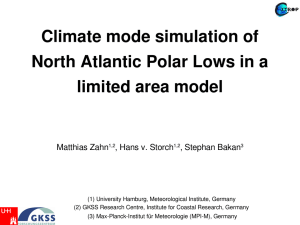Detection of North Atlantic Polar Lows in Climate Mode Simulations Matthias Zahn
advertisement
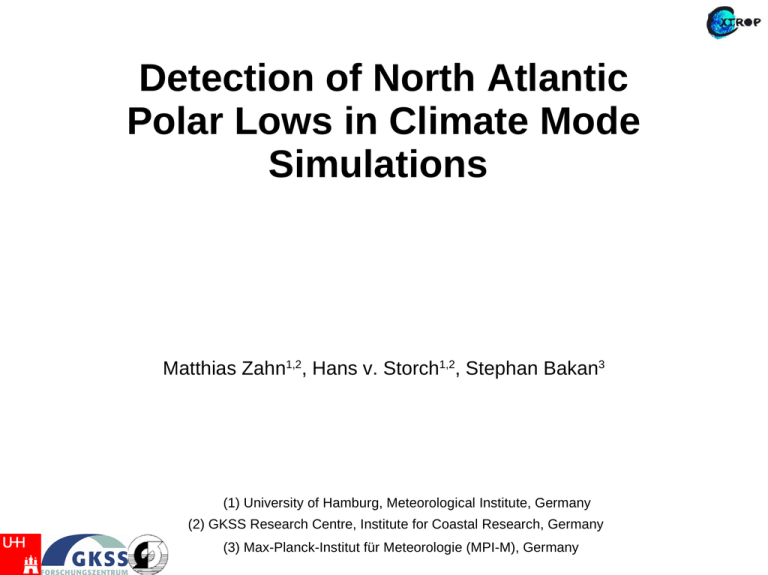
Detection of North Atlantic Polar Lows in Climate Mode Simulations Matthias Zahn1,2, Hans v. Storch1,2, Stephan Bakan3 (1) University of Hamburg, Meteorological Institute, Germany (2) GKSS Research Centre, Institute for Coastal Research, Germany (3) Max-Planck-Institut für Meteorologie (MPI-M), Germany • Background • Quality of Polar Lows in LAMs • Detection of Polar Lows Background My thesis: Trends and variability in extratropical mesoscale cyclones (VI EXTROP): Long term aim: climatological description of polar low occurrences (features) EXTROP, http://www.extrop.zmaw.de/ Background • Comprehensive measurements are required to address such a question (long in time, high in spatial detail, homogeneous) • Use of numerical models in combination with existing measurements to reconstruct the past state of the atmosphere • First part: capability of LAM's to reproduce polar lows • Second part: detection of polar lows • (Third part: derive climatology) PLows in CLM-data Ensemble simulations (2x4) with CLM ( ~50km ) in climate mode for polar low cases Oct. 1993 (and Dec. 1993, Jan. 1998) • Driven by the NCEP reanalysis • Initial times Initialisation PLow 2 weeks • Spectral Nudging (4x) and without (4x) • Different waves (above appr. 700 km) Hans von Storch, Heike Langenberg, and Frauke Feser, A Spectral Nudging Technique for Dynamical Downscaling Purposes, Monthly Weather Review 128(10) 3664-3673. http://clm.gkss.de/ 5 PLows in CLM-data Le Cygne Oct. 1993 synoptic scale low, “the Swan”, shallow baroclinic processes combined with upper level vorticity advection From Claud et.al Claud, C., G. Heinemann, E. Raustein and L. McMurdie, 2004: Polar low le Cygne: Satellite observations and numerical simulations. Quarterly Journal Of The Royal Meteorological Society, 130, 1075–1102 Nielsen,1997: An early Autumn polar low formation over the Norwegian Sea, J.Geophys. Res., 102, 13955-13973 PLows in CLM-data Le Cygne Oct. 1993 Mature state polar low: reaching peak intensity, wind speeds above gale force, closed small scale surface low From Claud et.al Claud, C., G. Heinemann, E. Raustein and L. McMurdie, 2004: Polar low le Cygne: Satellite observations and numerical simulations. Quarterly Journal Of The Royal Meteorological Society, 130, 1075–1102 Nielsen,1997: An early Autumn polar low formation over the Norwegian Sea, J.Geophys. Res., 102, 13955-13973 PLows in CLM-data Le Cygne Oct. 1993 decaying quickly after landfall From Claud et.al Claud, C., G. Heinemann, E. Raustein and L. McMurdie, 2004: Polar low le Cygne: Satellite observations and numerical simulations. Quarterly Journal Of The Royal Meteorological Society, 130, 1075–1102 Nielsen,1997: An early Autumn polar low formation over the Norwegian Sea, J.Geophys. Res., 102, 13955-13973 PLows in CLM-results 0600 UTC 15 Oct 1993 NCEP DWD 10m wind speed ≥ 13.9m/s and air pressure (at mean sea level) on 15 October 1993: NCEP/NCAR analysis after interpolation onto the CLM grid, 0600 UTC, DWD analysis data, 0600 UTC, CLM ensemble run without (nn) and with(sn) spectral nudging , 0900 UTC 9 PLows in CLM-results 0600 UTC 15 Oct 1993 NCEP CLM01-nn CLM02-nn DWD CLM03-nn CLM04-nn 10m wind speed ≥ 13.9m/s and air pressure (at mean sea level) on 15 October 1993: NCEP/NCAR analysis after interpolation onto the CLM grid, 0600 UTC, DWD analysis data, 0600 UTC, CLM ensemble run without (nn) and with(sn) spectral nudging , 0900 UTC 10 PLows in CLM-results 0600 UTC 15 Oct 1993 NCEP DWD CLM01-nn CLM02-nn CLM03-nn CLM04-nn CLM01-sn CLM02-sn CLM03-sn CLM04-sn 10m wind speed ≥ 13.9m/s and air pressure (at mean sea level) on 15 October 1993: NCEP/NCAR analysis after interpolation onto the CLM grid, 0600 UTC, DWD analysis data, 0600 UTC, CLM ensemble run without (nn) and with(sn) spectral nudging , 0900 UTC 11 PLows in CLM-results Track of polar low's local sea level pressure minimum in CLM-sn CLM01-sn CLM02-sn CLM03-sn CLM04-sn Start: 1500 UTC 14 Oct until 0000 UTC 16 Oct Not possible in CLM-nn 12 PLows in CLM-results 0600 UTC 15 Oct 1993 (Response function: wave lengths between appr. 200 and 600 km are retained) NCEP DWD CLM01-nn CLM02-nn CLM03-nn CLM04-nn CLM01-sn CLM02-sn CLM03-sn CLM04-sn Band-pass filtered mslp (isolines; hPa) and 10m wind speed anomalies, NCEP/NCAR analysis after interpolation onto the CLM grid, 0600 UTC, DWD analysis data, 0600 UTC, CLM ensemble run without and with spectral nudging, 0900 UTC. Black dots indicate the positions of the polar low's pressure minimum in the respective untreated field of the ensemble run. 13 PLows in CLM-results The 1993 case: NERC Dundee Satellite Receiving Station CLM22-sn, filtered 0000 UTC 9 Dec 1993 weatherchart, DWD, 0000 UTC 9 Dec 1993 CLM22-sn, full field 0000 UTC 9 Dec 1993 Rasmussen and Turner, 2003: Polar Lows: Mesoscale Weather Systems in the Polar Regions 14 PLows in CLM-results The 1998 case: NERC Dundee Satellite Receiving Station CLM01-sn, filtered 0000 UTC 18 Jan 1998 Weather chart, 0100 UTC 18 Jan 1998 CLM01-sn, full field 0000 UTC 18 Jan 1998 Woetmann Nielsen, N., Om forudsigelighed af polare lavtryk, Vejret, 20, 37–48, in Danish, 1998 15 PLows in CLM-results Results: •In principle, Polar Lows can be reproduced with CLM run in climate mode •Though, there may be deviations in location and amount of pressure minima •Without nudging the large scale, the formation of Polar Lows is subject to considerable ensemble variability •A digital filter could be useful for an automatic detection Zahn, M., H. von Storch, and S. Bakan, 2007: Climate mode simulation of North Atlantic Polar Lows in a limited area model, revised manuscript resubmitted to TellusA, 15 November 2007 16 PLows in CLM-results Results: •In principle, Polar Lows can be reproduced with CLM run in climate mode •Though, there may be deviations in location and amount of pressure minima •Without nudging the large scale, the formation of Polar Lows is subject to considerable ensemble variability •A digital filter could be useful for an automatic detection Application in longterm Simulations (2*sn and 2*nn) Oct 1993- Sept 1995 Zahn, M., H. von Storch, and S. Bakan, 2007: Climate mode simulation of North Atlantic Polar Lows in a limited area model, revised manuscript resubmitted to TellusA, 15 November 2007 17 Detectionalgorithm Setup of the detection algorithm applied 1st step: detection of all locations with a filtered mslp minimum < 1hPa 18 Detectionalgorithm Setup of the detection algorithm applied 1st step: detection of all locations with a filtered mslp minimum < 1hPa 2nd step: combine detected positions to individual tracks, distance to next (3h) pos < ~150 km 3rd step: checking further constraints along the tracks: 1. minimum in the filtered mslp field 2. wind speed >= 13,5 m/s 3. no synoptic low 4. a local minimum or trough in the untreated mslp field 5. atmospheric instability (decreasing vertical potential temperature between sea level and 700 hPa) SST −700hPa 0 mslp −700 hPa 19 Detectionresults Detected tracks according to these criteria Simulation period: Oct 1993 until Sep 1995, CLMsn Winters (ONDJFM) Summers (AMJJAS) Detectionresults Example: October tracks CLMsn CLMnn Detectionresults Monthly frequency distributions: von:http://www.eumetcal.org.uk/polarlow/ Lystad, M., 1986: Polar lows in the Norwegian, Greenland and Barents Sea - Final Report. Norwegian Meteorological Institute, Oslo, Norway, 196 pp. Noer, G. and M. Ovhed, 2003: Forecasting of polar lows in the Norwegian and the Barents Sea. Proc. of the 9th meeting of the EGS Polar Lows Working Group, Cambridge, UK, 2003. 22 Wilhelmsen, K., 1985: Climatological Study Of Gale-Producing Polar Lows Near Norway. Tellus, 37A, 451–459 Detectionresults Number of medial positions of detected tracks in CLMsn and CLMnn: Zahn, M., M. and H. von Storch, 2008: Climatological differences of reproduced North Atlantic Polar Lows in long term 23 simulations with CLM, submitted to Meteorologische Zeitschrift Final results Final results (of this presentation) • In principle, Polar Lows can be reproduced with CLM run in climate mode • Though, there may be deviations in location and amount of pressure minima • A digital filter could be useful for an automatic detection Results of the application of the detection algorithm Spatial digital bandpass filters applied to LAM output fields represent a simple method to automatically identify and track meso-scale disturbances ● Temporal frequency distributions qualitatively are similar to those expected ● Smaller number of detected Polar Low tracks in CLMsn compared to CLMnn ● 24 Outlook Outlook Paper describing (and enhancing) the algorithm Comparison with observed Cases (A.Blechschmidt) 25 Thank you very much 26
